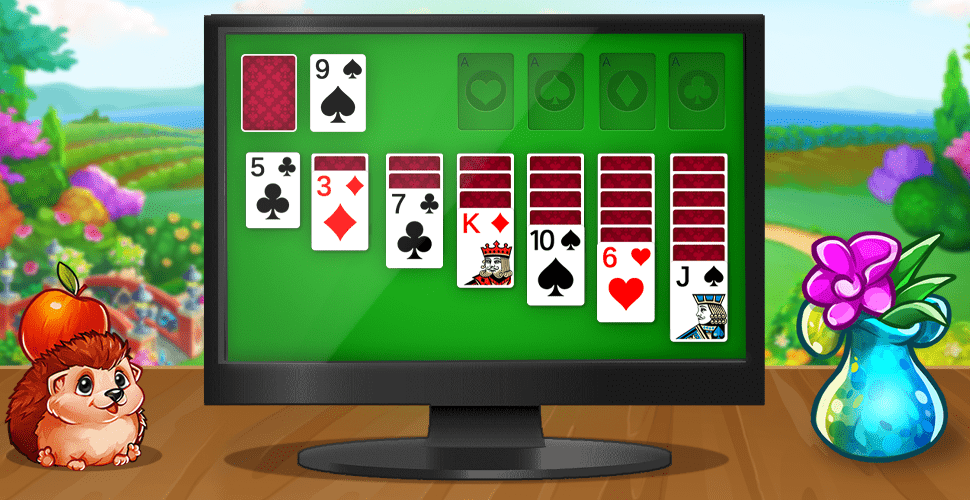
Solitaire Is Becoming Digital
For decades Solitaire has been played by millions on computers worldwide. Today there is a whole generation of Solitaire fans whose first exposure to the game was free Solitaire on the computer. Yet, Solitaire predates the first appearance of computer Solitaire by almost 200 years. So, when did Solitaire first appear in a digital format? And how did technology revolutionize this centuries-old game?
When Was Computer Solitaire Invented?
One of the first games to have come into prominence simultaneously with the PC was Solitaire. The reason for this is simple. At the time, personal computers had just been developed, and there were no major technological upgrades. Solitaire was a perfect fit for those that could afford PCs when they were first sold. It is probably wise to know how long has Solitaire been around at this point. 
Initially, Solitaire on computer was mainly text-mode running on single-game software. With innovations in the tech industry, developers had no choice but to eventually improve the game’s graphics. They also began to combine multiple Solitaire games into what would later be known as the Solitaire collection.
Unlike before, the collection had mouse support, which significantly improved simple text input. It was also commercially available in 1987 for both Microsoft and Macintosh.
Furthermore, Solitaire’s Journey, a video game, was put out in 1992 by Quantum Quality Productions. Solitaire’s Journey offered 105 Solitaire games to choose from, and players had the freedom to build custom journeys through a subset of the games. One of the more appealing features allowed players to participate in “quests” and locate “treasure,” but they first had to finish a set of solitaire games successfully.
In 1990, Solitaire made its debut appearance with Microsoft Windows 3.0. All players needed to do was drag and drop the cards. After that, Windows 95 became prominent, and everyone entered a frenzy. The version known as “FreeCell” became a sensation almost immediately with several shareware versions. This wide acceptance would later inspire Microsoft XP to upgrade to Spider Solitaire. Likewise, Solitaire Plus! and Solitaire Till Dawn were developed for Macintosh. Although the inventor of Solitaire remains debatable, the inventor of the Solitaire computer game is known: Intern Wes Cherry made it all happen in 1990.
Thanks to technological advancements, Solitaire is now compatible with most operating systems. The game can now be played on smartphones as well. Players can immerse themselves or engage their friends in a game of Solitaire at anytime, anywhere. We strongly recommend you to try our Solitaire Social game to play online in any browser or device.
Klondike in Analog
When we discuss the history of Solitaire, we are talking about the history of Klondike Solitaire. Solitaire was first known as Patience. And it initially appears in historical records in a German book published in 1788. Then, as the game grew in popularity, references appeared in Swedish, Russian, and French writing from the 1800s forward. Finally, the first card solitaire book appeared in the United States in 1870 under the title Patience: A Series of Thirty Games with Cards by Ednah Cheney.
Klondike Solitaire arrived in the 1913 edition of Official Rules of Card Games. At the time, it was titled Seven-Card Klondike. This was to distinguish it from another game in the same book titled Klondike. Today we know the latter Klondike as Canfield Solitaire. Eventually, Seven-Card Klondike was shortened to Klondike. Meanwhile, Klondike’s popularity continued to grow. And it soon became the most popular version of Solitaire in the world.
Solitaire on Atari 8-Bit (1981)
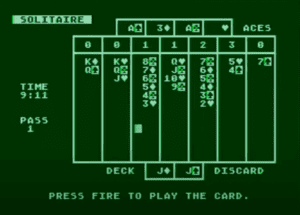 Atari was the first computer platform to release a digital version of Solitaire. Their 8-bit version of 1-Card Klondike first appeared in the Atari Program Exchange catalog. The Program Exchange was a collection of user-written programs compatible with Atari home computers. In the 1981 winter edition, Atari featured a digital version of Klondike submitted by Atari-user Mark Reid.
Atari was the first computer platform to release a digital version of Solitaire. Their 8-bit version of 1-Card Klondike first appeared in the Atari Program Exchange catalog. The Program Exchange was a collection of user-written programs compatible with Atari home computers. In the 1981 winter edition, Atari featured a digital version of Klondike submitted by Atari-user Mark Reid.
The gameplay would be considered clunky by modern standards. But, at the time, it was revolutionary. The 8-bit graphics featured a simple green matrix screen with each card represented by a number or letter next to the suit. Users used the Atari joystick to navigate the blinking cursor across the screen. They would then select the cards with the fire button before moving the card to a new stack.
The game featured none of the automation or graphics players are accustomed to today. Even the action of moving a card from the draw pile to the discard was a manual one. Still, for the first time in history, players could play Solitaire on the computer.
Klondike for the Macintosh (1984)
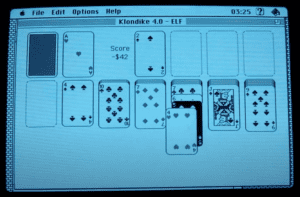 1984 saw the arrival of a Solitaire computer game for the Macintosh personal computer. This was 3-Card Klondike and was the first digital version to include the sort of graphics and automation that would become standard in later computer Solitaire games.
1984 saw the arrival of a Solitaire computer game for the Macintosh personal computer. This was 3-Card Klondike and was the first digital version to include the sort of graphics and automation that would become standard in later computer Solitaire games.
This was also the first commercially available version to boast graphic representations of the cards. In addition, it featured basic levels of automation. This included the ability to click on the draw pile to draw the next 3 cards and the automatic return of cards to their stack when an illegal move occurred.
This version also assisted players by highlighting legal moves for a selected card and activating a “Cheat” button when no more moves were available. However, the most significant leap forward in the user experience was the ability to drag cards between stacks using the arrow cursor and trackball.
Solitaire in Microsoft Windows (1990)
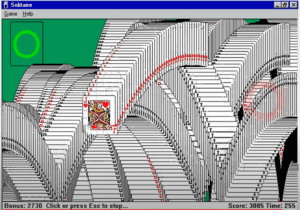
Solitaire win on Wondows
The release of Windows 3.0 included the first version of Microsoft Solitaire. This digital iteration of Klondike was developed by Wes Cherry with the deck designed by Susan Kare and was released in 1990.
Initially, Microsoft Solitaire was considered an educational aid. The Windows user interface was still novel for many PC users. And Solitaire allowed them to get comfortable using the innovative mouse, including new features like drag-and-drop. Microsoft Solitaire quickly became the third most used program on Windows, even over professional programs like Word and Excel.
It was also the first to feature victory graphics, such as the bouncing cards, which are now a staple of many digital versions of Solitaire. In addition, Microsoft allowed players to choose between 1-Card and 3-Card Klondike and select different scoring conventions. User-friendly features such as these laid the foundation for Microsoft Solitaire’s induction into the World Video Game Hall of Fame in 2019 as recognition for its contribution to Solitaire computer games worldwide.
Clubhouse Games for Nintendo (2005)
Nintendo released Clubhouse Games on the Nintendo DS in Japan in 2005 and Europe and North America in 2006. It featured 42 classic games, including various board and card games. Klondike Solitaire was among them.
The game was such a hit that Nintendo released an updated version for the Nintendo Switch in 2020. This version included 9 additional classic games, including Spider Solitaire. This addition effectively added the Nintendo family of game systems to the growing list of consoles that now have Solitaire.
As technology evolves, so too do consumer preferences. Gaming technology has taken giant leaps forward in the past decade, removing the need for players to invest in purpose-built consoles to enjoy a high-quality gaming experience. One might think that online Solitaire would struggle to maintain its appeal in the age of increasingly complicated games. However, that is not the case.
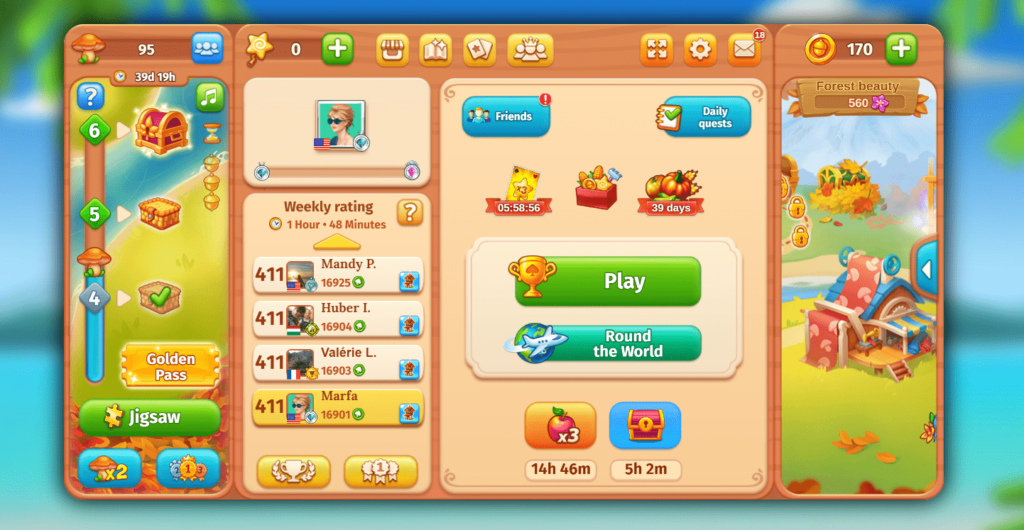 Enter Solitaire Social. Solitaire Social is the latest stage in the proud lineage of computer Solitaire. But it is so much more than a basic game of Klondike. Instead, Solitaire Social provides a new twist on the classic 1-Card Klondike by adding a competitive element and a whole stack of unique features.
Enter Solitaire Social. Solitaire Social is the latest stage in the proud lineage of computer Solitaire. But it is so much more than a basic game of Klondike. Instead, Solitaire Social provides a new twist on the classic 1-Card Klondike by adding a competitive element and a whole stack of unique features.
Solitaire Social allows players to play Solitaire on the computer against others from across the globe in tiered tournaments. Winning competitions supply special rewards for players to collect. These rewards provide in-game power-ups as well as unlock dozens of unique decks.
Power-ups in Solitaire Social come in the form of magic and spells. Each provides a special advantage during gameplay. They can reveal blocked cards, reshuffle the draw deck, freeze your opponents, or open moves when nothing else is available. Magic makes every game winnable and adds an exciting twist to the tournaments.
Solitaire Social is easy to understand and a good way to learn how to play Solitaire on computer.
Who Invented the Card Game Solitaire?
For years, efforts to successfully trace the game Solitaire to a definite origin have proved unsuccessful. The game started a very long time ago, which is one reason why it is difficult to pinpoint who invented the solitaire card game. Despite the challenge of discovering Solitaire’s origins, many theories have been put forward.
 According to one theory, Solitaire is the brainchild of a French aristocrat who was condemned to prison in the 17th century. Going deeper, historians have noted that this period witnessed the rule of the notorious King Louis XIV, who had a penchant for imprisoning nobles, especially those who were not his relations. However, several scholars have punctured holes in this story, describing it as inconsistent. On the other hand, many others give credence to this history, believing that a French Aristocrat did indeed invent the card game Solitaire.
According to one theory, Solitaire is the brainchild of a French aristocrat who was condemned to prison in the 17th century. Going deeper, historians have noted that this period witnessed the rule of the notorious King Louis XIV, who had a penchant for imprisoning nobles, especially those who were not his relations. However, several scholars have punctured holes in this story, describing it as inconsistent. On the other hand, many others give credence to this history, believing that a French Aristocrat did indeed invent the card game Solitaire.
Another theory posits that Pelisson, a French mathematician, invented Solitaire game to entertain the Sun King, the nickname of Louis XIV. In 1697, Anne de Rohan-Chabot and Princess Soubise were portrayed as playing cards. princess playing peg solitaireThis French engraving may very well be the first documentation of the game. However, there’s a wide consensus that this engraving was only a forerunner of the Solitaire card game. The oldest version of the game has been identified as Peg Solitaire or Solo Noble.
Essentially, the identity of the person who invented Solitaire varies by theory. Nevertheless, plenty of information about the game is still known. First, Solitaire is a game of antiquity, a classical game from times past. Its endurance is likely due to how and why it is played: No occasion is required, and anyone can play it anywhere.
Since its inception a long time ago, players have battled the game of Solitaire to their utmost satisfaction. However, the odds of winning the game were only discovered in 2019. So, how exactly was this problem solved? Mathematicians only needed to collaborate with programming experts to bring their expertise to bear. In the end, these professionals developed a computer program to solve the complex calculations.
Who Invented the Game Speed Solitaire?
Reinhard Staupe created speed Solitaire, but it was first published by Adlung-Spiele in 1995. Although the game is originally for two players, you can play with up to six people.
Per the game’s rules, once players run out of cards, they are expected to slam or knock on the table and shout, “Speed!” A player can also slap both cards.
Why Is Solitaire Called Solitaire?
In England, Germany, and Poland, Solitaire used to be called “Patience,” but it was known as “Cabale” in Scandinavian countries.
The root word of Solitaire is “sol,” meaning “alone,” a perfect description of the game. Solitaire was not a game for two players until recently. It used to be (and often still is) played alone. Even though Solitaire has gone by many names, each version reflects the basic principles and strategy of the game: time and patience. Ultimately, a player derives much joy, pleasure, fulfillment, and satisfaction if they win the game of Solitaire.
Is Solitaire Good for the Mind?
Perhaps unsurprisingly, playing Solitaire on the computer or manually comes with many benefits. This is lucky since the game is also engaging as well as time-consuming. Like many other card games, Solitaire is a game of the mind, encouraging a high level of thought. To see how effective Solitaire can be on the mind, one need only look to Napoleon.

Condemned to isolation, Napoleon could have very well lost his mind. However, that is the exact opposite of what happened. Napoleon had to take solace in solitude when he was banished to St. Helena. And one way he maintained his mental acuity, according to the story, was by playing Solitaire. This is just one example of how powerful Solitaire can be. It is also worth noting that the game was adopted to improve the well-being of patients in mental asylums.
According to research conducted in the United States, the average American scrolls through social media for about 5 hours a day, reducing cognitive capacity. Unlike social media, playing Solitaire on the computer can improve mental agility. For instance, if one were to develop their physical muscles, they would exercise at the gym several times a week. If Solitaire is a kind of mental “gym,” the metaphor applies. The player has to put in 100% concentration, strategize, and stretch their mind to its fullest capacity. Over time, one’s problem-solving and quick-thinking abilities will most definitely improve if they are disciplined enough.
What does the history of Solitaire card game tell us?
The history of Klondike Solitaire is one rich in innovation and fun facts. Its inventor is unknown, but the many fascinating theories might interest and impress any Solitaire afficionado.
- Solitaire for newbies
- September 29, 2022


